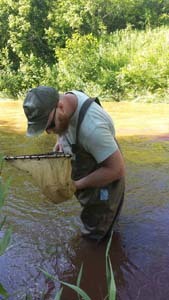|
July 18, 2016
Contact: Seth Herbst (DNR), 517-284-5830 or Dr. Brian Roth (MSU), 517-353-7854
Crayfish monitoring to begin this month in Upper Peninsula

The Michigan Department of Natural Resources and Michigan State University are partnering together this summer to monitor crayfish populations in the Upper Peninsula. Approximately 140 sites across the U.P. will be sampled by field crews to determine the distribution of native and invasive crayfish.
The DNR’s Fisheries Division and MSU have been working together since 2014 on a crayfish study to better understand populations throughout the state. Crayfish populations are often under-represented when it comes to natural resource sampling, but these organisms have a big influence on the communities they inhabit.
So far the study has focused its sampling efforts on the waters of the Lower Peninsula, resulting in detailed information on the distribution of Michigan’s eight native crayfish species, along with the one known invasive – rusty crayfish. The project will now expand to include the U.P. with field crews beginning their sampling efforts this month.
“This study is primarily evaluating potential introduction pathways for invasive crayfish,” said the project’s principal investigator, Dr. Brian Roth from MSU. “The U.P. sampling will provide the DNR with statewide information on crayfish populations that can be used to inform invasive species management and evaluate current status of the native populations.”
Rusty crayfish are the most widespread invasive crayfish in Michigan, initially introduced to the state’s waters via the live release of unused bait. Native to Ohio, Indiana and Kentucky, the rusty crayfish has the ability to negatively alter aquatic habitats and organisms.
“The rusty crayfish’s feeding behavior reduces the native plant community and removes spawning, feeding and shelter habitats for many of Michigan’s popular fish species and can lead to population declines,” said DNR aquatic invasive species coordinator Seth Herbst. “Understanding the distribution of this particular species can assist with targeted prevention efforts.”
Anglers and the public may encounter MSU students conducting the sampling. Those who do are encouraged to ask questions and learn about the impact rusty crayfish can have.
For more information on rusty crayfish, visit Michigan.gov/invasives.
/Note to editors: Accompanying photos are available below for download. Suggested captions follow.
Rusty Crayfish - MI Sea Grant.JPG - Michigan State University students will be on the lookout for the invasive rusty crayfish while sampling Upper Peninsula bodies of water this summer.
IMG_O567.JPG - The public may encounter several Michigan State University students conducting a crayfish survey on behalf of the DNR in the U.P. this summer./
The Michigan Department of Natural Resources is committed to the conservation, protection, management, use and enjoyment of the state’s natural and cultural resources for current and future generations. For more information, go to www.michigan.gov/dnr.
|







